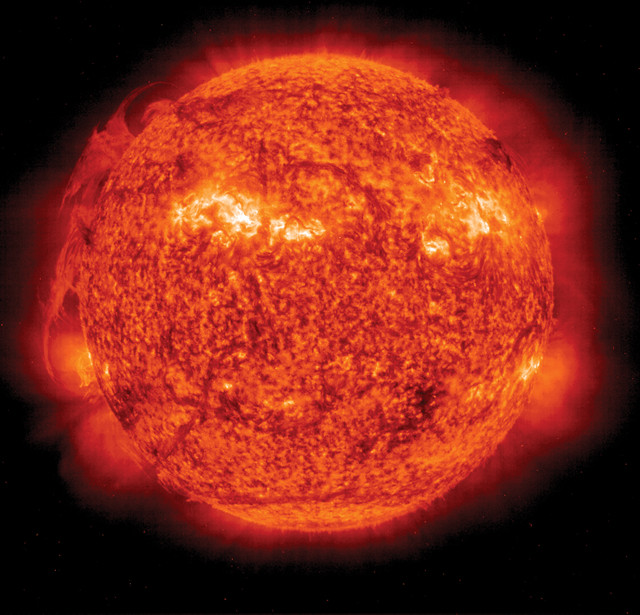
by Mary Caperton Morton Thursday, October 8, 2015

Solar activity may play a role in incidences of rheumatoid arthritis and giant cell arteritis, two autoimmune diseases. Credit: SOHO (ESA & NASA).
For hundreds of years, humans have charted the appearance of sunspots, the changing frequency of which marks highs and lows in the sun’s 11-year solar cycle. Peaks in the solar cycle cause surges in the amount of solar radiation reaching Earth, which can lead to changes in weather and climate, and can disrupt radio signals and electrical grids. Now, researchers have found that the solar cycle may also affect human health, with cases of rheumatoid arthritis and giant cell arteritis seeming to spike in concert with solar fluctuations.
Rheumatoid arthritis (RA) and giant cell arteritis (GCA) are autoimmune diseases in which the body mistakenly attacks its own organs and tissues, leading to painful inflammation and swelling of the joints in patients with RA or inflammation of the arteries in those with GCA. Since the 1950s, the Mayo Clinic in Rochester, Minn., has compiled data on the incidences of RA and GCA in North America — defined as the number of new cases per capita per year — and the records show that both disorders follow roughly 10-year cycles.
“That got me curious,” says Simon Wing, a space physicist at the Johns Hopkins University Applied Physics Lab in Laurel, Md., and lead author of the new study published in the journal BMJ Open. “Only a few things in nature have a periodicity of about 10 to 11 years, and the solar cycle is one of them.”
To see how closely the incidence rates of RA and GCA match up with the solar cycle, Wing and Lisa Rider, a rheumatologist with the Environmental Autoimmunity Group at the National Institutes of Health in Bethesda, Md., assembled a cross-disciplinary team of physicists and medical professionals. When the team plotted the incidence of RA and GCA cases against the geomagnetic activity generated by the sun’s fluctuating solar cycles, they found “more than a coincidental connection,” says co-author Eric Matteson, chair of the division of rheumatology at the Mayo Clinic.
“Frankly, we were very surprised by this correlation,” Matteson says. “We don’t have a good understanding of what triggers rheumatoid arthritis, but the onset of the disease seems to result from a complex interaction of genetic susceptibility and environmental influences,” such as smoking and exposure to ultraviolet light, he says. “This study was an interesting look at an environmental influence we hadn’t previously considered.”
In the researchers’ analysis, the incidence of GCA peaked within one year after the most intense geomagnetic activity, while the incidence of RA fell to a minimum within one year after the least intense activity. The findings offer a possible explanation for previous studies that looked at the geographic distribution of RA cases in the U.S. and found a greater incidence of the disease at higher latitudes, which are more likely to be affected by geomagnetic activity, Wing says.
While the correlations are notable, not everybody is ready to accept a causal link between solar cycles and autoimmune diseases. “Correlation is not [the same as] causality,” says Doug Biesecker, a physicist at NOAA’s Space Weather Prediction Center in Boulder, Colo., who was not involved with the new research. “From a basic-science perspective, correlations are interesting. They are a reason to dig deeper, but they are not an answer.”
This new study is the first to look at the link between solar cycles and autoimmune disease at this level of detail, but many other previous studies have tried to link the sun’s cycles to an array of different phenomena, Biesecker says. “Solar cycles are a very popular field of study. If you have something that runs on [roughly] 10-year cycles, somebody somewhere has tried to see if it matches up with the sun,” he says.
As this study focused exclusively on cases in Minnesota, the next step should be to repeat the analysis for other places, Biesecker says. “They should be able to repeat this study in any other geographic location and see the same pattern, since changes in solar cycle are visible from everywhere on Earth. It still won’t prove causality, but it will be a more significant finding.”
There is no known mechanism through which the solar cycle could be triggering higher incidence rates of autoimmune diseases, but Wing and colleagues have a few ideas, including that production of melatonin, a hormone that enhances the immune system, is reduced during periods of high geomagnetic activity. Fluctuating geomagnetic fields could also trigger the formation of free radicals in susceptible individuals, contributing to autoimmune diseases. A number of other autoimmune diseases, including lupus and multiple sclerosis, are thought to be affected by the sun and by ultraviolet light exposure, Matteson says, although the disease pathways are poorly understood.
“At this point, we need more interdisciplinary studies and collaborations between biophysicists, molecular biologists, rheumatologists and space physicists,” Wing says. “Obviously, geomagnetic activity doesn’t affect everybody — the overall incidence of RA and GCA is low in the general population — but it seems that a small number of people may be more susceptible to geomagnetic effects than others.”
© 2008-2021. All rights reserved. Any copying, redistribution or retransmission of any of the contents of this service without the expressed written permission of the American Geosciences Institute is expressly prohibited. Click here for all copyright requests.